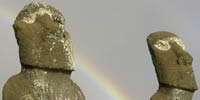Big Stone Heads




 7:45
Jack Chance
7:45
Jack Chance
Who made and moved the Moai?
Broadcast: Jul 23 2007 on HV PODCAST; Mar 14 2007 on HV Webwork; Mar 7 2007 on PRX Nature Stories Podcast; Nov 14 2004 on NPR Day to Day Subjects: Music, Historical, International, Native
Profile: Easter Island
May 25, 2004 from Day to Day
ALEX CHADWICK, host: And now 2,000 miles off the west coast of South America, Easter Island is the most remote island on Earth, the most remote one with people on it. Anthropologists think it was settled by Polynesian sailors around the year 300 AD. And in 1722, a Dutch ship landed there. Sailors were astounded by what they found, and Easter Island is still astounding, as we hear in this audio postcard from producer Jack Chance.
(Soundbite of waves)
JACK CHANCE (Producer): The thing about Easter Island is that it's in the middle of nowhere, a thousand miles from the nearest anything. An otherwise unimportant island in the South Pacific; otherwise unimportant if it weren't for the moai--you know, the big stone heads. You've probably seen them on TV.
(Soundbite of hammering)
KAI(ph): (Singing in foreign language)
CHANCE: That's Kai, a local sculptor. His yard is full of works in progress carved from wood scraps or red volcanic rock. Over there is a gravestone for his father, who passed away last week. Since Kai seems to be carrying on the sculpting craft of his ancestors, I figured maybe he could clue me in on how the mysterious moai were built.
KAI: (Foreign language spoken)
CHANCE: He tells me the ancient Rapanui chiefs possessed supernatural mental powers and, with a little help from some martians, made the statues stand up and walk.
(Soundbite of hammering)
CHANCE: He's just messing with me, but legend says that the moai, which can weigh up to 80 tons, walked from the volcanic quarry to their positions along the rocky coast.
(Soundbite of hammering; waves)
CHANCE: I decided to walk around the island for a few days, checking out petroglyphs hidden in the grass and the half-buried moai, left unfinished at the quarry or lying derelict along the shoreline.
(Soundbite of waves)
CHANCE: Some archaeologists think the moai were transported by rowing the immense stone sculptures on top of the trunks of palm trees. But the few trees here today were introduced by foreigners, so if these archaeologists are right, the Rapanui deforested their island completely when they built their statues.
(Soundbite of waves)
CHANCE: The moai aren't revealing any of their secrets. They just gaze over the barren landscape. Anyway, I'm no archaeologist. I came to the most remote inhabited island on Earth to hear what kind of music the locals play.
(Soundbite of music)
Mr. PAPA KIKO and Unidentified Student: (Singing in unison in foreign language)
CHANCE: Lucky for me I run into Dan Benders(ph), an Australian ethnomusicologist working on his PhD. After months of research on the island, he's brought one of the most respected Rapanui musicians out of retirement. Together with another student, Papa Kiko sings us this song, which he wrote when the first moai were restored in 1960.
(Soundbite of music)
Mr. KIKO and Unidentified Student: (Singing in unison in foreign language)
Mr. DAN BENDERS: The lyrics describe their pride in seeing this memory of their ancestors being lifted up again, having been destroyed and ruined previously.
(Soundbite of music)
Mr. KIKO and Unidentified Student: (Singing in unison in foreign language)
CHANCE: The thing about Easter Island is that there are no trees. The palms went extinct centuries ago so the locals could move those big stone heads. They went extinct to move the big stone heads so there wasn't any wood left, no wood to build boats for fishing or to leave the island. Some of the greatest navigators who ever lived have found little old Easter Island out in the empty blue waters, and there's no wood left to go fishing, no wood for fires, no wood to escape. No wood left because they built those big stone heads.
You know some guy went to work one day and his boss says, `Totay(ph), cut down that palm over there.' And Totay looks at the last tree on the island and he goes and does his job. He cuts down the last tree on the island and there's no more wood. And Totay gets his paycheck and the people go hungry and turn to war and cannibalism and they topple every last one of the big stone heads. And the white folks come on an Easter Sunday and they baptize the non-believers with hydrochloric acid and the islanders get smallpox on the slave ships while their families back home sit on the reservations. And then the white people find out about the toppled heads and the dying culture and they come back with anthropologists and photographers to marvel at the big stone heads all toppled on the ground. And the anthropologists and photographers bring some money and they resurrect the big stone heads and the tourists come and they let the locals off the reservations and the locals grow dreadlocks and raise horses in the treeless hills, 'cause Totay went to work one day and left them all stranded.
CHADWICK: Jack Chance is an independent radio producer. He comes to us through the folks at HearingVoices.com, the friend of independent producers everywhere.
Unidentified Group: (Singing in unison in foreign language)
CHADWICK: This is DAY TO DAY from NPR News.

